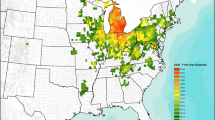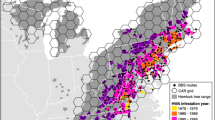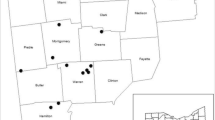Abstract
The emerald ash borer (EAB) Agrilus planipennis, first detected in 2002 in the vicinity of Detroit, Michigan, USA, is one of the most recent in a long list of introduced insect pests that have caused serious damage to North American forest trees, in this case ash trees in the genus Fraxinus. We used data from Project FeederWatch, a citizen science program focused on winter bird populations, to quantify the effects of EAB invasion on four species of resident, insectivorous birds known or likely to be EAB predators: three woodpecker species and the white-breasted nuthatch (Sitta canadensis). We compared relative numbers of birds within 50 km of the epicenter of the region where EAB was first detected, an area known to have suffered high ash tree mortality by 2008, to numbers 50–100 km from the epicenter and to control sites within 50 km of five comparable Midwestern cities where damage due to EAB has yet to be severe. We found evidence for significant effects on all four of the species in response to the EAB invasion in the highly impacted region, with red-bellied woodpeckers (Melanerpes carolinus) and white-breasted nuthatches showing numerical increases while downy woodpeckers (Picoides pubescens) and hairy woodpeckers (Picoides villosus) initially declined but exhibited at least temporary increases several years later. Temporal correlation analyses failed to provide support for immigration being a major cause of the elevated numbers in the highly impacted area, and thus these results are consistent with the hypothesis that increases were due to enhanced survival and/or reproduction associated with the EAB invasion within the highly impacted area. Results suggest that the continuing invasion of EAB into new areas is likely to significantly alter avian communities, although not always in ways that will be easy to predict.


Similar content being viewed by others
References
Barber NA, Marquis RJ, Tori WP (2008) Invasive prey impacts the abundance and distribution of native predators. Ecology 89:2678–2683
Baxter CV, Fausch KD, Murakami M, Chapman PL (2004) Fish invasion restructures stream and forest food webs by interrupting reciprocal prey subsidies. Ecology 85:2656–2663
Beisner BE, Ives AR, Carpenter SR (2003) The effects of an exotic fish invasion on the prey communities of two lakes. J Anim Ecol 72:331–342
Blackburn TM, Cassey P, Duncan RP, Evans KL, Gaston KJ (2004) Avian extinction and mammalian introductions on oceanic islands. Science 305:1955–1958
Bonsall MB, Hassell MP (1997) Apparent competition structures ecological assemblages. Nature 388:371–373
Bonter DN, Cooper CB (2012) Data validation in citizen science: a case study from Project FeederWatch. Front Ecol Environ 10:305–307
Bonter DN, Hochachka WM (2009) A citizen science approach to ornithological research: twenty years of watching backyard birds. In: Rich TD, Arizmendi C, Demarest E, Thompson C (eds) Tundra to tropics: connecting birds, habitats and people. McAllen, TX: Proceedings of 4th International Partners in Flight Conference, pp 453–458
Branch GM, Steffani CN (2004) Can we predict the effects of alien species? A case-history of the invasion of South Africa by Mytilus galloprovincialis (Lamarck). J Exp Mar Biol Ecol 300:189–215
Cappaert D, McCullough DG, Poland T (2005a) The upside of the emerald ash borer catastrophe: a feast for woodpeckers. In: Mastro V, Reardon R (eds) Emerald ash borer research and technology development meeting. USDA Forest Service Pub FHTET-2004-15, Romulus, pp 69–70
Cappaert D, McCullough DG, Poland TM, Siegert NW (2005b) Emerald ash borer in North America: a research and regulatory challenge. Am Entomol 51:152–165
Chamberlain DE, Gosler AG, Glue DE (2007) Effects of the winter beechmast crop on bird occurrence in British gardens: capsule woodland birds were significantly less likely to occur in gardens in years of high beechmast crop. Bird Study 54:120–126
Cockle KL, Martin K, Wesołowski T (2011) Woodpeckers, decay, and the future of cavity-nesting vertebrate communities worldwide. Front Ecol Environ 9:377–382
Cooper CB, Hochachka WM, Dhondt AA (2007) Contrasting natural experiments confirm competition between house finches and house sparrows. Ecology 88:864–870
Covert-Bratland KA, Block WM, Theimer TC (2006) Hairy woodpecker winter ecology in ponderosa pine forests representing different ages since wildfire. J Wildl Manag 70:1379–1392
D’Antonio CM, Vitousek PM (1992) Biological invasions by exotic grasses, the grass–fire cycle, and global change. Annu Rev Ecol Syst 23:63–87
Dickinson JL, Zuckerberg B, Bonter DN (2010) Citizen science as an ecological research tool: challenges and benefits. Annu Rev Ecol Evol Syst 41:149–172
Duan JJ, Ulyshen MD, Bauer LS, Gould J, Van Driesche R (2010) Measuring the impact of biotic factors on populations of immature emerald ash borers (Coleoptera: Buprestidae). Environ Entomol 39:1513–1522
Ehrenfeld JG (2003) Effects of exotic plant invasions on soil nutrient cycling processes. Ecosystems 6:503–523
Fry JA, Xian G, Jin S, Dewitz JA, Homer CG, Yang L, Barnes CA, Herold ND, Wickham JD (2011) Completion of the 2006 National Land Cover database for the conterminous United States. Photogramm Eng Remote Sensing 77:858–864
Grubb TC Jr, Pravosudov VV (2008) White-breasted nuthatch (Sitta carolinensis). In: Poole A (ed) The Birds of North America Online. Cornell Lab of Ornithology Ithaca. Retrieved from the Birds of North America Online: http://bna.birds.cornell.edu/bna/species/054
Holt RD (1977) Predation, apparent competition, and the structure of prey communities. Theor Pop Biol 12:197–229
Husheer SW, Coomes DA, Robertson AW (2003) Long-term influences of introduced deer on the composition and structure of New Zealand Nothofagus forests. For Ecol Manag 181:99–117
Jackson JA, Ouellet HR (2002) Downy woodpecker (Picoides pubescens) In: Poole A (ed) The Birds of North America Online. Cornell Lab of Ornithology, Ithaca. Retrieved from the Birds of North America Online: http://bna.birds.cornell.edu/bna/species/613
Koenig WD, Liebhold AM (2005) Effects of periodical cicada emergences on abundance and synchrony of avian populations. Ecology 86:1873–1882
Koenig WD, Walters EL, Liebhold AM (2011) Effects of gypsy moth outbreaks on North American woodpeckers. Condor 113:352–361
Kovacs KF, Haight RG, McCullough DG, Mercader RJ, Siegert NW, Leibhold AM (2010) Cost of potential emerald ash borer damage in U.S. communities, 2009–2019. Ecol Econ 69:569–578
Lepage D, Francis CM (2002) Do feeder counts reliably indicate bird population changes? 21 years of winter bird counts in Ontario, Canada. Condor 104:255–270
Liebhold AM, Elkinton JS (1991) Gypsy moth dynamics. Trends Ecol Evol 6:263–264
Lindell CA, McCullough DG, Cappaert D, Apostolou NM, Roth MB (2008) Factors influencing woodpecker predation on emerald ash borer. Am Midl Nat 159:434–444
MacFarlane DW, Meyer SP (2005) Characteristics and distribution of potential ash tree hosts for emerald ash borer. For Ecol Manag 213:15–24
McCullough DG, Siegert NW (2007) Estimating potential emerald ash borer (Coleoptera: Buprestidae) populations using ash inventory data. J Econ Entomol 100:1577–1586
Meiners SJ (2007) Apparent competition: an impact of exotic shrub invasion on tree regeneration. Biol Invasions 9:849–855
Murphy EC, Lehnhausen WA (1998) Density and foraging ecology of woodpeckers following a stand-replacement fire. J Wild Manag 62:1359–1372
Nappi A, Drapeau P, Saint-Germain M, Angers VA (2010) Effect of fire severity on long-term occupancy of burned boreal conifer forests by saproxylic insects and wood-foraging birds. Int J Wildland Fire 19:500–511
Poland TM, McCullough DG (2006) Emerald ash borer: invasion of the urban forest and the threat to North America’s ash resource. J For 104:118–124
Pugh SA, Liebhold AM, Morin RS (2011) Changes in ash tree demography associated with emerald ash borer invasion, indicated by regional forest inventory data from the Great Lakes states. Can J For Res 41:2165–2175
R Development Core Team (2009) R: a language and environment for statistical computing: R Foundation for Statistical Computing, Vienna, Austria. ISBN3-900051-07-0, URL http://www.R-project.org
Rodriguez LF (2006) Can invasive species facilitate native species? Evidence of how, when, and why these impacts occur. Biol Invasions 8:927–939
Settle WH, Wilson LT (1990) Invasion by the variegated leafhopper and biotic interactions: parasitism, competition, and apparent competition. Ecology 71:1461–1470
Shackelford CE, Brown RE, Conner RN (2000) Red-bellied woodpecker (Melanerpes carolinus) In: Poole A (ed) The Birds of North America Online. Cornell Lab of Ornithology, Ithaca. Retrieved from the Birds of North America Online: http://bna.birds.cornell.edu/bna/species/650
Siegert NW, McCullough DG, Liebhold AM, Telewski FW (2009) Reconstruction of the establishment and spread of emerald ash borer through dendrochronological analysis. In: McManus K, Gottschalk KW (eds) Proceedings of 19th USDA interagency research forum on invasive species, Gen Tech Rep NRS-P-36 USDA Forest Service, Annapolis, MD, Northern Research Station, Newtown Square, PA, 70
Smith KG, Withgott JN, Rodewald PG (2000) Red-headed woodpecker (Melanerpes erythrocephalus). In: Poole A (ed) The Birds of North America Online. Cornell Lab of Ornithology, Ithaca. Retrieved from the Birds of North America Online: http://bna.birds.cornell.edu/bna/species/518
Smith EL, Storer AJ, Roosien BK (2009) Emerald ash borer infestation rates in Michigan, Ohio, and Indiana. In: McManus K, Gottschalk KW (eds) Proceedings of 20th interagency research forum on invasive species, Gen Tech Rep NRS-P-51, Annapolis, MD, USDA Forest Service, Northern Research Station, Newtown Square, PA, p 96
States SL, Hochachka WM, Dhondt AA (2009) Spatial variation in an avian host community: implications for disease dynamics. EcoHealth 6:540–545
Strayer DL, Malcom HM (2007) Effects of zebra mussels (Dreissena polymorpha) on native bivalves: the beginning of the end or the end of the beginning? J North Am Benthol Soc 26:111–122
Wang X-Y, Yang Z-Q, Gould JR, Zhang Y-N, Liu G-J, Liu E (2010) The biology and ecology of the emerald ash borer, Agrilus planipennis, in China. J Insect Sci 10(128):1–23
Wells JV, Rosenberg KV, Dunn EH, Tessaglia-Hymes DL, Dhondt AA (1998) Feeder counts as indicators of spatial and temporal variation in winter abundance of resident birds. J Field Ornithol 69:577–586
Acknowledgments
We thank Project FeederWatch participants and donors for their continuing support and the reviewers for their comments. Incidental support came from NSF grant IOS-0918944 to WDK. Special thanks to Ben Zuckerberg for extracting the landcover data.
Author information
Authors and Affiliations
Corresponding author
Rights and permissions
About this article
Cite this article
Koenig, W.D., Liebhold, A.M., Bonter, D.N. et al. Effects of the emerald ash borer invasion on four species of birds. Biol Invasions 15, 2095–2103 (2013). https://doi.org/10.1007/s10530-013-0435-x
Received:
Accepted:
Published:
Issue Date:
DOI: https://doi.org/10.1007/s10530-013-0435-x




